Comparison of Product Life Cycle Cost Estimating Models Based on Neural Networks and Parametric Techniques—A Case Study for Induction Motors
Abstract
:1. Introduction
2. Materials and Methods
2.1. Production System of the Company
2.2. Parametric Cost Estimation of the Product Life Cycle
2.3. Artificial Neural Networks in the Product Life Cycle Cost Estimation
3. Results
3.1. Regression Analysis as a Comparative Model
3.2. Performance Comparison
- ANNs in the product life cycle cost estimation;
- Parametric cost estimation of the product life cycle.
4. Discussion
5. Conclusions
Author Contributions
Funding
Conflicts of Interest
References
- Kunkel, S.; Matthess, M. Digital transformation and environmental sustainability in industry: Putting expectations in Asian and African policies into perspective. Environ. Sci. Policy 2020, 112, 318–329. [Google Scholar] [CrossRef]
- Morariu, C.; Morariu, O.; Răileanu, S.; Borangiu, T. Machine learning for predictive scheduling and resource allocation in large scale manufacturing systems. Comput. Ind. 2020, 120, 103244. [Google Scholar] [CrossRef]
- Armengaud, E.; Sams, C.; von Falck, G.; List, G.; Kreiner, C.; Riel, A. Industry 4.0 as digitalization over the entire product lifecycle: Opportunities in the automotive domain. In Communications in Computer and Information Science; Springer: Cham, Switzerland, 2017; Volume 748, pp. 334–351. ISBN 9783319642178. [Google Scholar]
- Brozzi, R.; Forti, D.; Rauch, E.; Matt, D.T. The Advantages of Industry 4.0 Applications for Sustainability: Results from a Sample of Manufacturing Companies. Sustainability 2020, 12, 3647. [Google Scholar] [CrossRef]
- Garetti, M.; Rosa, P.; Terzi, S. Life Cycle Simulation for the design of Product–Service Systems. Comput. Ind. 2012, 63, 361–369. [Google Scholar] [CrossRef]
- Norris, G.A. Integrating life cycle cost analysis and LCA. Int. J. Life Cycle Assess. 2001, 6, 118–120. [Google Scholar] [CrossRef]
- Kloepffer, W. Life cycle sustainability assessment of products. Int. J. Life Cycle Assess. 2008, 13, 89–95. [Google Scholar] [CrossRef]
- Farr, J.V.; Faber, I.J.; Ganguly, A.; Martin, W.A.; Larson, S.L. Simulation-based costing for early phase life cycle cost analysis: Example application to an environmental remediation project. Eng. Econ. 2016, 61, 207–222. [Google Scholar] [CrossRef]
- Rush, C.; Roy, R. Expert Judgement in Cost Estimating: Modelling the Reasoning Process. Concurr. Eng. 2001, 9, 271–284. [Google Scholar] [CrossRef] [Green Version]
- Roy, R. Cost engineering: Why, what and how? In Decision Engineering Report Series; Roy, R., Kerr, C., Eds.; Cranfield University: Bedfordshire, UK, 2003; ISBN 1-861940-96-3. [Google Scholar]
- Horngren, C.T.; Srikant, M.D.; Madhav, R. Cost Accounting: A Managerial Emphasis, 15th ed.; Prentice Hall: Upper Saddle River, NJ, USA, 2014. [Google Scholar]
- Farfan, R.F.M.; Zambrano, T.Y.M.; Solís, A.A.H.; Badillo, F.R.A.; Bravo, J.J.P. Life Cycle of 240 mL Insulated Beakers: Cradle to Door. Int. J. Adv. Sci. Technol. 2020, 29, 5289–5298. [Google Scholar]
- Bravo-Fritz, C.P.; Sáez-Navarrete, C.A.; Herrera-Zeppelin, L.A.; Varas-Concha, F. Multi-scenario energy-economic evaluation for a biorefinery based on microalgae biomass with application of anaerobic digestion. Algal Res. 2016, 16, 292–307. [Google Scholar] [CrossRef]
- Pelzeter, A. Building optimisation with life cycle costs–the influence of calculation methods. J. Facil. Manag. 2007, 5, 115–128. [Google Scholar] [CrossRef]
- Ten Brinke, E.; Lutters, E.; Streppel, T.; Kals, H. Cost estimation architecture for integrated cost control based on information management. Int. J. Comput. Integr. Manuf. 2004, 17, 534–545. [Google Scholar] [CrossRef]
- Mauchand, M.; Siadat, A.; Bernard, A.; Perry, N. Proposal for tool-based method of product cost estimation during conceptual design. J. Eng. Des. 2008, 19, 159–172. [Google Scholar] [CrossRef]
- Anderson, D.M. Design for Manufacturability. Productivity Press: New York; NY, USA, 2014; ISBN 9780429255588. [Google Scholar]
- Hegazy, T. Computer-Based Construction Project Management; Prentice Hall: Upper Saddle River, NJ, USA, 2002; ISBN 978-0130888594. [Google Scholar]
- Duverlie, P.; Castelain, J.M. Cost Estimation During Design Step: Parametric Method versus Case Based Reasoning Method. Int. J. Adv. Manuf. Technol. 1999, 15, 895–906. [Google Scholar] [CrossRef]
- Huang, X.X.; Newnes, L.B.; Parry, G.C. The adaptation of product cost estimation techniques to estimate the cost of service. Int. J. Comput. Integr. Manuf. 2012, 25, 417–431. [Google Scholar] [CrossRef]
- Niazi, A.; Dai, J.S.; Balabani, S.; Seneviratne, L. Product Cost Estimation: Technique Classification and Methodology Review. J. Manuf. Sci. Eng. 2006, 128, 563–575. [Google Scholar] [CrossRef]
- Chang, K.H. Product Manufacturing and Cost Estimating Using CAD/CAE: A Volume in the Computer Aided Engineering Design Series; Academic Press: Cambridge, MA, USA, 2013; ISBN 9780124017450. [Google Scholar]
- Tyagi, S.; Cai, X.; Yang, K. Product life-cycle cost estimation: A focus on the multi-generation manufacturing-based product. Res. Eng. Des. 2015, 26, 277–288. [Google Scholar] [CrossRef]
- Smith, A.E.; Mason, A.K. Cost Estimation Predictive Modeling: Regression Versus Neural Network. Eng. Econ. 1997, 42, 137–161. [Google Scholar] [CrossRef]
- Dysert, L.R. Estimating. In Skills & Knowledgeof Cost Engineering; Scott, J.A., Ed.; AACE International: Morgantown, VA, USA, 2004. [Google Scholar]
- Bode, J. Neural networks for cost estimation: Simulations and pilot application. Int. J. Prod. Res. 2000, 38, 1231–1254. [Google Scholar] [CrossRef]
- Medicine, J. Artificial Intelligence Business Applications: A New Approach to AI and Machine Learning in Modern Business and Marketing, for Beginners and Advanced; John Medicine: USA, 2019; ISBN 978-1085989428. [Google Scholar]
- Zhang, Y.F.; Fuh, J.Y.H.; Chan, W.T. Feature-based cost estimation for packaging products using neural networks. Comput. Ind. 1996, 32, 95–113. [Google Scholar] [CrossRef]
- Wang, Q.; Stockton, D.J.; Baguley, P. Process cost modelling using neural networks. Int. J. Prod. Res. 2000, 38, 3811–3821. [Google Scholar] [CrossRef]
- Seo, K.-K.; Park, J.-H.; Jang, D.-S.; Wallace, D. Approximate Estimation of the Product Life Cycle Cost Using Artificial Neural Networks in Conceptual Design. Int. J. Adv. Manuf. Technol. 2002, 19, 461–471. [Google Scholar] [CrossRef]
- Garza, J.M.; Rouhana, K.G. Neural networks versus parameter-based applications in cost estimating. Cost Eng. 1995, 37, 14–18. [Google Scholar]
- Kim, G.-H.; An, S.-H.; Kang, K.-I. Comparison of construction cost estimating models based on regression analysis, neural networks, and case-based reasoning. Build. Environ. 2004, 39, 1235–1242. [Google Scholar] [CrossRef]
- Ikeda, M.; Hiyama, T. ANN based designing and cost determination system for induction motor. IEE Proc.-Electr. Power Appl. 2005, 152, 1595. [Google Scholar] [CrossRef]
- Weckman, G.R.; Paschold, H.W.; Dowler, J.D.; Whiting, H.S.; Young, W.A. Using Neural Networks with Limited Data to Estimate Manufacturing Cost. J. Ind. Syst. Eng. 2010, 3, 257–274. [Google Scholar]
- Karaoglan, A.D.; Karademir, O. Flow time and product cost estimation by using an artificial neural network (ANN): A case study for transformer orders. Eng. Econ. 2017, 62, 272–292. [Google Scholar] [CrossRef]
- Liu, X.; Kang, S.; Li, F. Simulation of artificial neural network model for trunk sap flow of Pyrus pyrifolia and its comparison with multiple-linear regression. Agric. Water Manag. 2009, 96, 939–945. [Google Scholar] [CrossRef]
- Jiao, L.; Li, H. QSPR studies on the aqueous solubility of PCDD/Fs by using artificial neural network combined with stepwise regression. Chemom. Intell. Lab. Syst. 2010, 103, 90–95. [Google Scholar] [CrossRef]
- Chelgani, S.C.; Hower, J.C.; Hart, B. Estimation of free-swelling index based on coal analysis using multivariable regression and artificial neural network. Fuel Process. Technol. 2011, 92, 349–355. [Google Scholar] [CrossRef]
- McCulloch, W.S.; Pitts, W. A logical calculus of the ideas immanent in nervous activity. Bull. Math. Biophys. 1943, 5, 115–133. [Google Scholar] [CrossRef]
- Kolmogorov, A.N. Selected works of A.N. Kolmogorov; Mikhailovich, T.V., Ed.; Kluwer: Philadelphia, PA, USA, 1991; ISBN 978-9402417081. [Google Scholar]
- Leszczyński, Z.; Jasiński, T. An artificial neural networks approach to product cost estimation. The case study for electric motor. Inform. Ekon. 2018, 1, 72–84. [Google Scholar] [CrossRef]
- Rosenblatt, F. The perceptron: A probabilistic model for information storage and organization in the brain. Psychol. Rev. 1958, 65, 386–408. [Google Scholar] [CrossRef] [PubMed] [Green Version]
- Broomhead, D.S.; Lowe, D. Radial Basis Functions, Multi-Variable Functional Interpolation and Adaptive Networks; Royal Signals and Radar Establishment: London, UK, 1988. [Google Scholar]
- Neugebauer, S.; Forin, S.; Finkbeiner, M. From Life Cycle Costing to Economic Life Cycle Assessment—Introducing an Economic Impact Pathway. Sustainability 2016, 8, 428. [Google Scholar] [CrossRef] [Green Version]
- Wood, R.; Hertwich, E.G. Economic modelling and indicators in life cycle sustainability assessment. Int. J. Life Cycle Assess. 2013, 18, 1710–1721. [Google Scholar] [CrossRef]
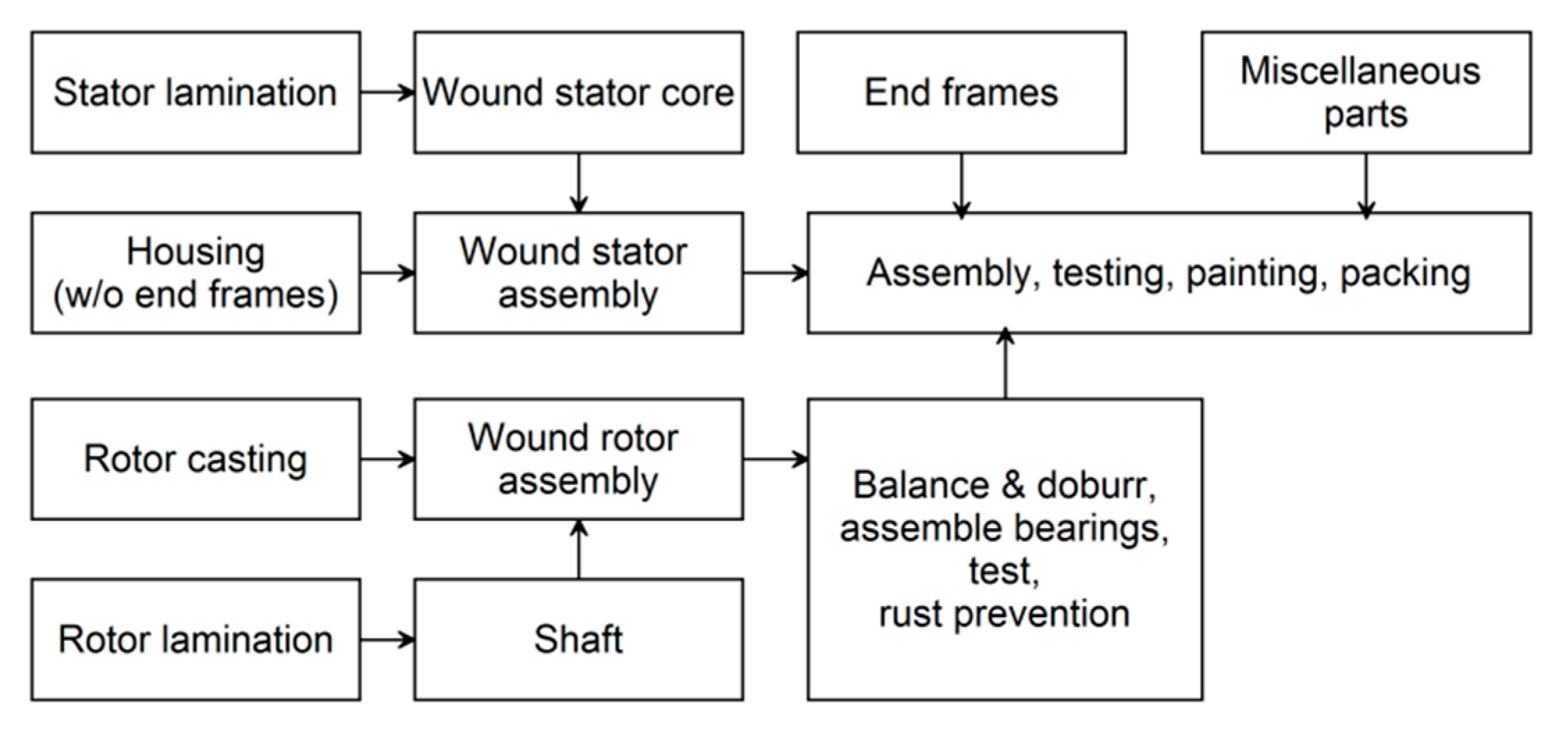
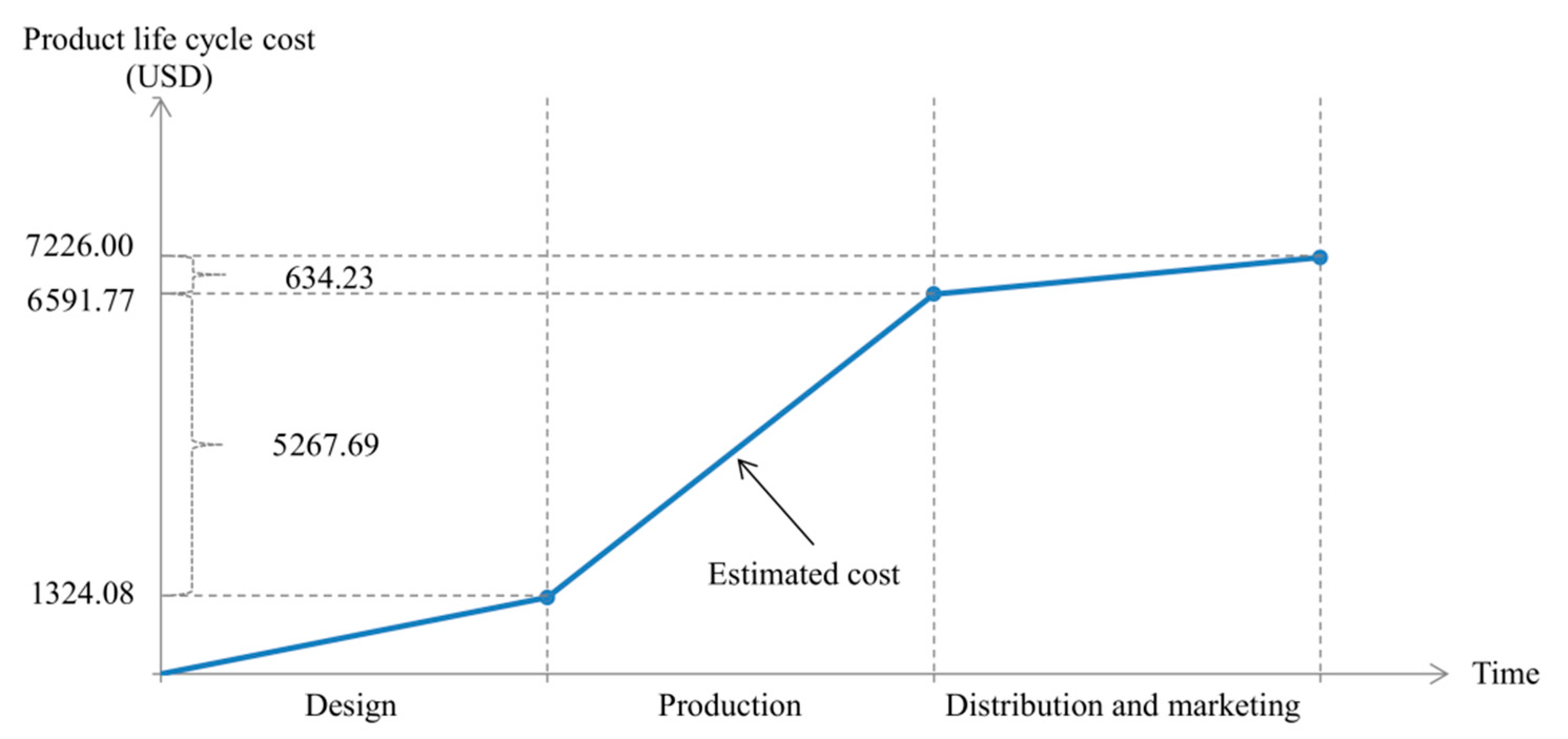
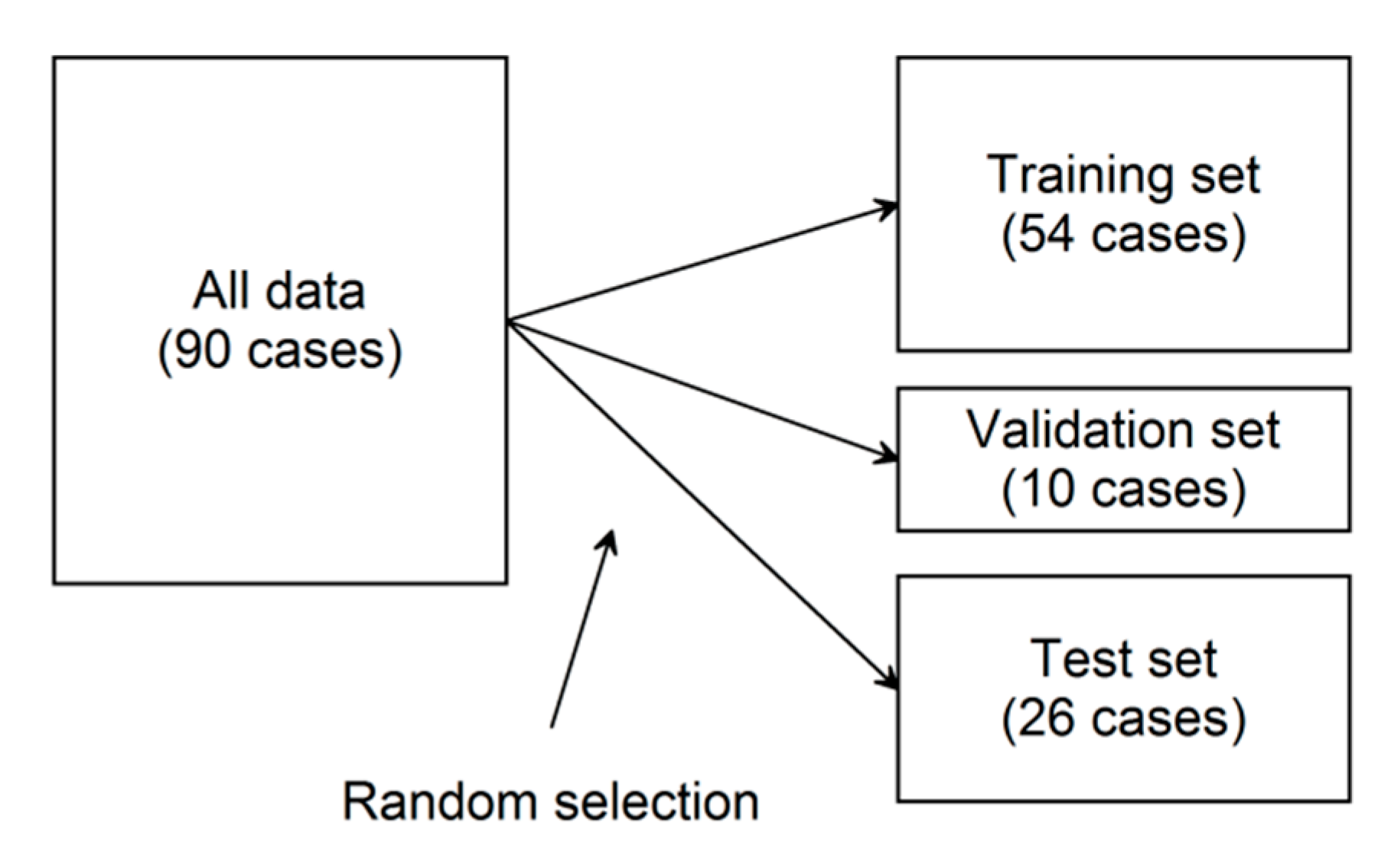
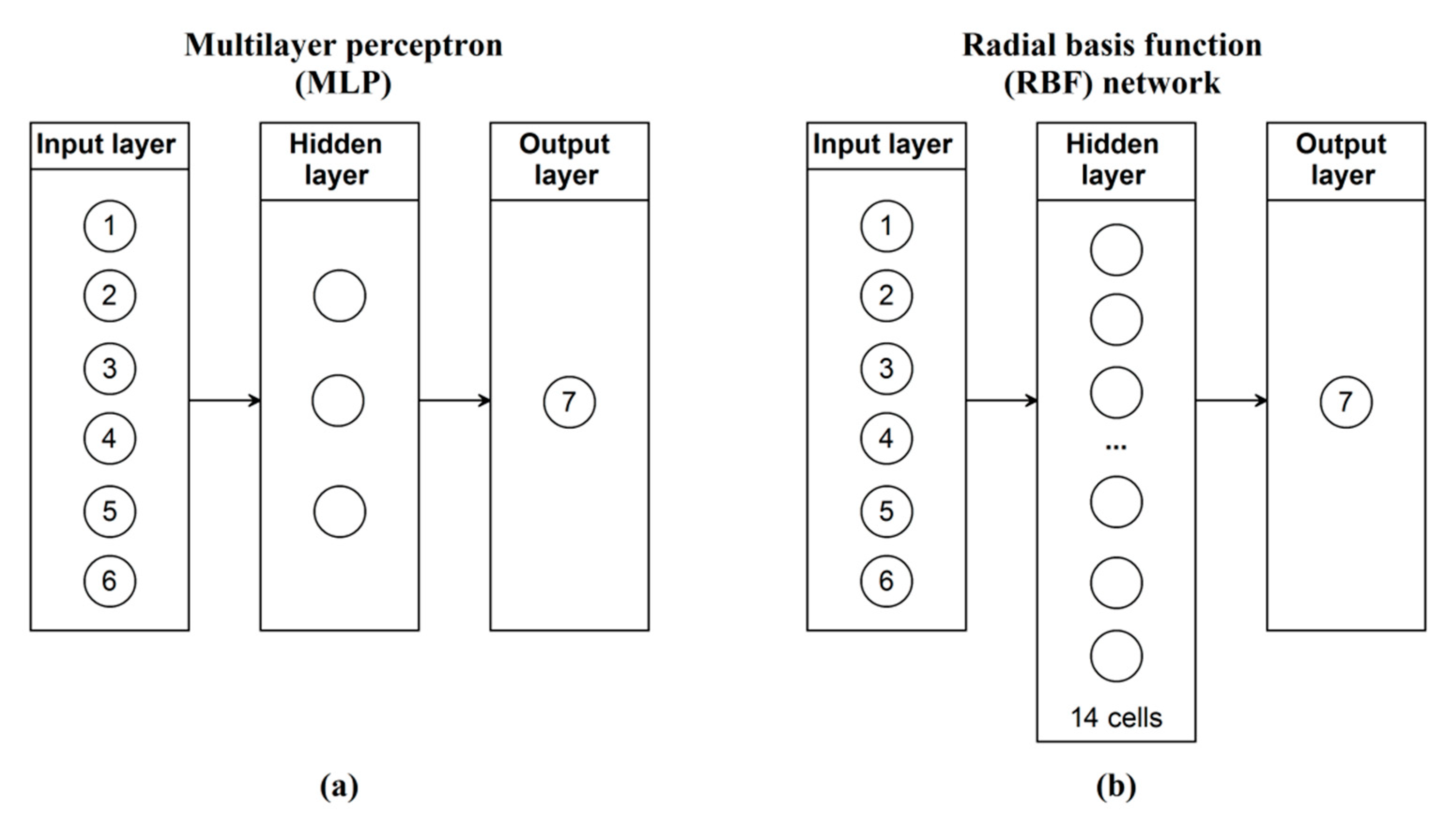

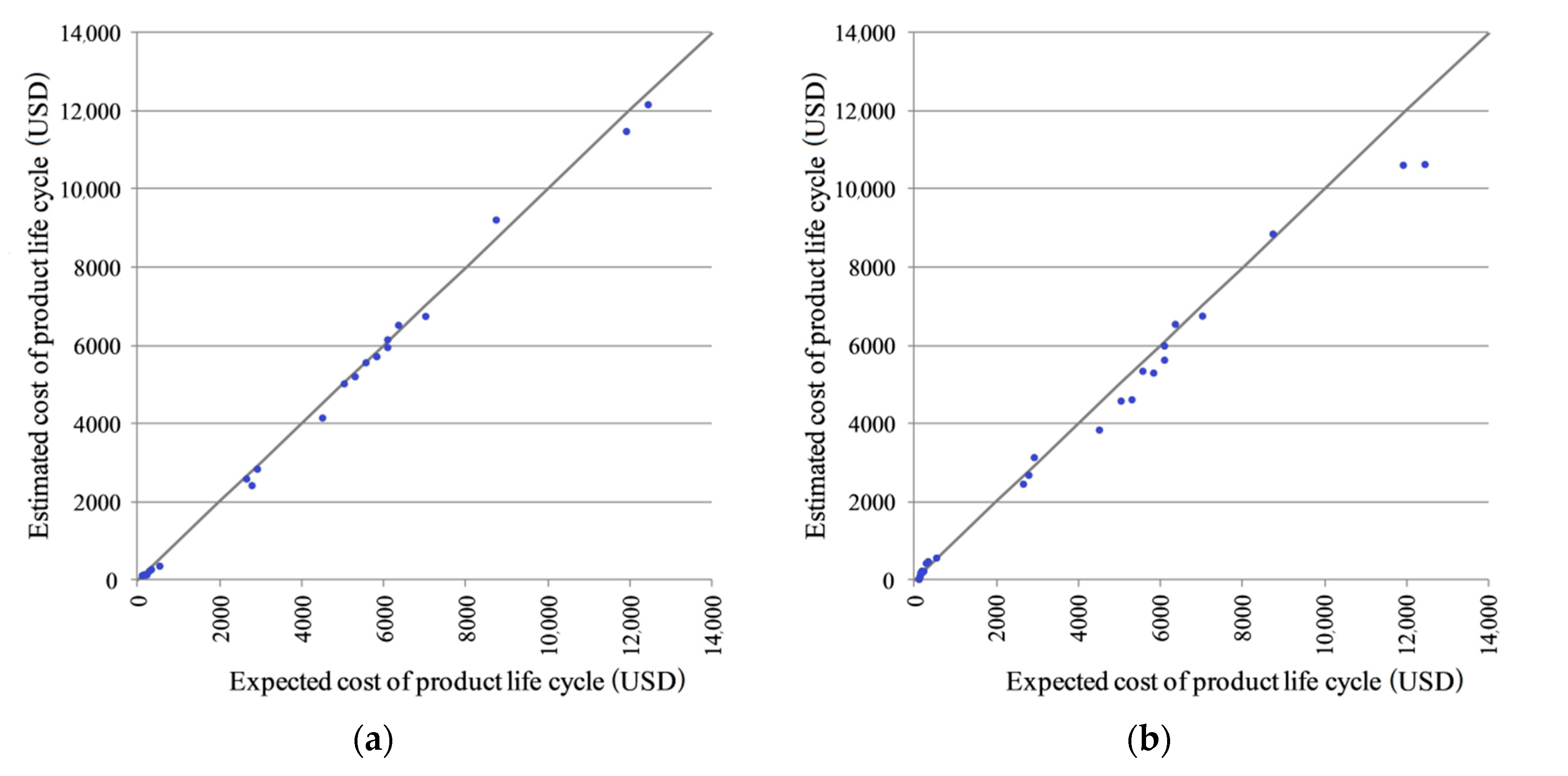
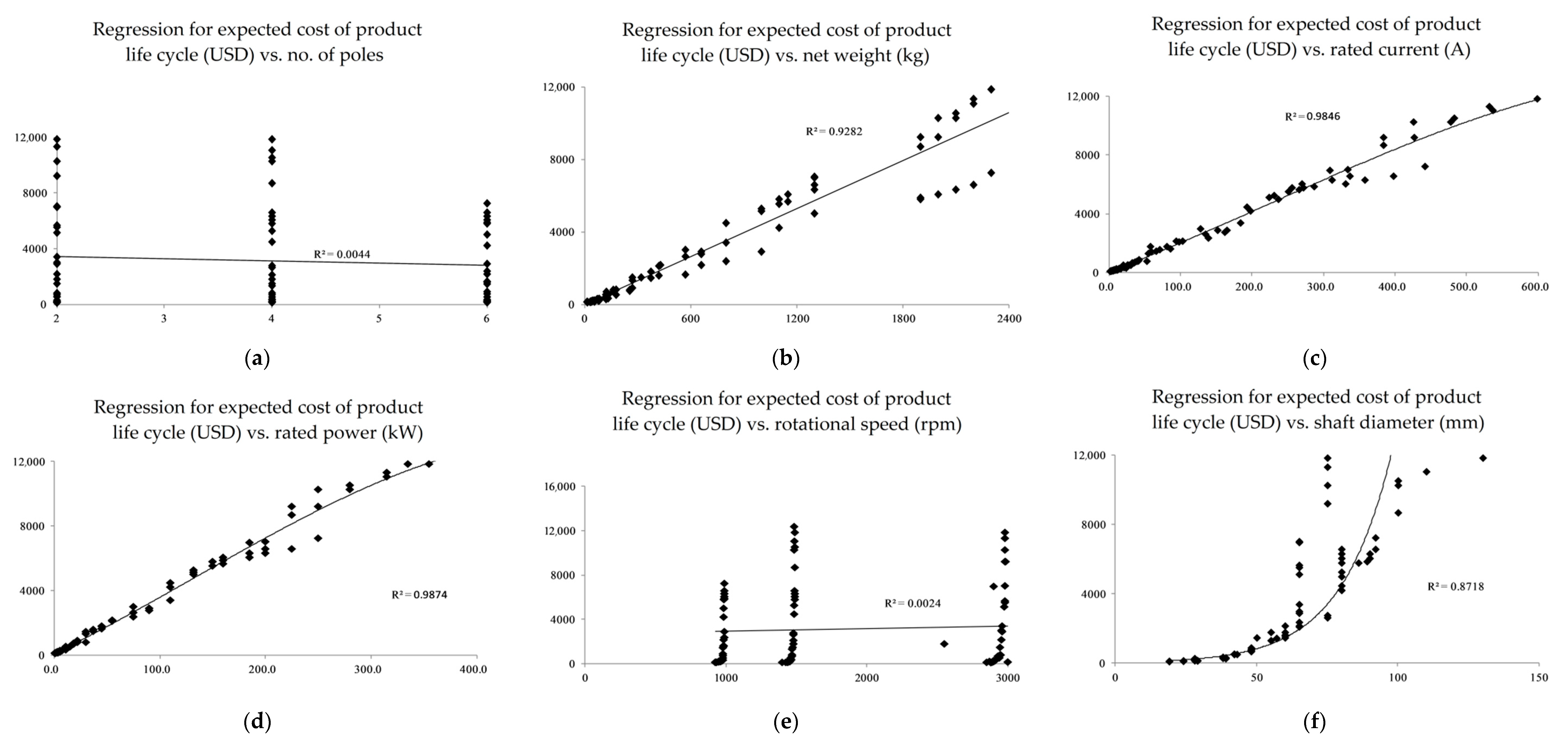
| Type | Rated Power (kW) | Rated Current 1 (A) | Rated Voltage (V) | Rotational Speed (rpm) | Pole Number | Net Weight (kg) |
|---|---|---|---|---|---|---|
| 4Sm412H-6-AT5 | 250 | 442 | 400 | 990 | 6 | 2300 |
| Phase Name | Cost Estimating Relationship (CER) |
|---|---|
| I. Design phase | 1324.08 |
| Product design, process design, research and development, orders and deliveries, testing, corrections of the project, etc. | |
| II. Production phase | 5267.69 |
| Direct materials, direct labor, overhead production costs (variable costs), and overhead production costs (fixed costs). | |
| III. Distribution and marketing phase | 634.23 |
| Advertisements, fairs and exhibitions, marketing research, staff training, transportations, packaging materials, after-sales services, etc. | |
| Product life cycle cost (I + II + III) | 7226.00 |
| Case Number | Rated Power (kW) | Rated Current 1 (A) | Rotational Speed (rpm) | Number of Poles | Net Weight (kg) | Shaft Diameter (mm) |
|---|---|---|---|---|---|---|
| 1 | 250.0 | 442.0 | 990 | 6 | 2300 | 92 |
| 2 | 90.0 | 162.0 | 1480 | 4 | 660 | 75 |
| 3 | 75.0 | 128.0 | 2960 | 2 | 570 | 65 |
| 4 | 150.0 | 251.0 | 2980 | 2 | 1100 | 65 |
| 5 | 5.5 | 10.2 | 2910 | 2 | 70 | 28 |
| No. | Variable Name | Unit |
|---|---|---|
| Input variables | ||
| 1 | Rated power | kW |
| 2 | Rated current | A |
| 3 | Rotational speed | rpm |
| 4 | No. of poles | – |
| 5 | Net weight | kg |
| 6 | Shaft diameter | mm |
| Output variable | ||
| 7 | Product life cycle cost | USD |
| Parameter Name | Value |
|---|---|
| Multilayer perceptron (MLP) | |
| Number of hidden layers | 1 |
| Number of neurons at the hidden layer | 3 |
| Number of neurons at the input layer | 6 |
| Number of neurons at the output layer | 1 |
| Activation functions of hidden layer neurons | Logistic |
| Activation functions of output layer neuron | Exponential |
| Learning algorithm | Broyden-Fletcher-Goldfarb-Shanno (BFGS) |
| Error function | Sum of squares (SOS) |
| Number of epochs | 102 |
| Radial basis function (RBF) network | |
| Number of neurons at the hidden layer | 14 |
| Number of neurons at the input layer | 6 |
| Number of neurons at the output layer | 1 |
| Activation functions of hidden layer neurons | Gaussian |
| Activation functions of output layer neuron | Identity |
| Learning algorithm | Reduced Breadth-First Search |
| Error function | SOS |
| Regression Model | R2 for Tested Functions of Regression 1 | ||
|---|---|---|---|
| Logarithmic | Exponential | Polynomial | |
| Rated power vs. expected cost of product life cycle | R2 = 0.7052 | R2 = 0.7602 | R2 = 0.9874 |
| Rated current vs. expected cost of product life cycle | R2 = 0.7170 | R2 = 0.7633 | R2 = 0.9846 |
| Shaft diameter vs. expected cost of product life cycle | R2 = 0.6638 | R2 = 0.8718 | R2 = 0.8013 |
| Case Number | Expected Value (USD) | ANN | Parametric Estimation | ||
|---|---|---|---|---|---|
| Estimated Value (USD) | Percentage Error (PE) (%) | Estimated Value (USD) | PE (%) | ||
| 1 | 7240 | 7230 | 0.14% | 7226 | 0.19% |
| 2 | 2763 | 2712 | 1.85% | 2478 | 10.31% |
| 3 | 2995 | 2950 | 1.50% | 3500 | 14.43% |
| 4 | 5526 | 5545 | 0.34% | 4900 | 11.33% |
| 5 | 276 | 280 | 1.43% | 250 | 9.42% |
| … | … | … | … | … | … |
| PE (%) for the entire test set | 1.10% | 8.86% | |||
© 2020 by the authors. Licensee MDPI, Basel, Switzerland. This article is an open access article distributed under the terms and conditions of the Creative Commons Attribution (CC BY) license (http://creativecommons.org/licenses/by/4.0/).
Share and Cite
Leszczyński, Z.; Jasiński, T. Comparison of Product Life Cycle Cost Estimating Models Based on Neural Networks and Parametric Techniques—A Case Study for Induction Motors. Sustainability 2020, 12, 8353. https://doi.org/10.3390/su12208353
Leszczyński Z, Jasiński T. Comparison of Product Life Cycle Cost Estimating Models Based on Neural Networks and Parametric Techniques—A Case Study for Induction Motors. Sustainability. 2020; 12(20):8353. https://doi.org/10.3390/su12208353
Chicago/Turabian StyleLeszczyński, Zbigniew, and Tomasz Jasiński. 2020. "Comparison of Product Life Cycle Cost Estimating Models Based on Neural Networks and Parametric Techniques—A Case Study for Induction Motors" Sustainability 12, no. 20: 8353. https://doi.org/10.3390/su12208353





